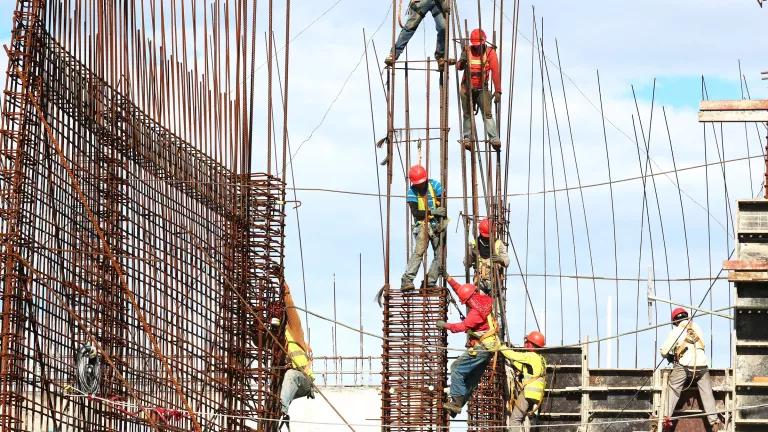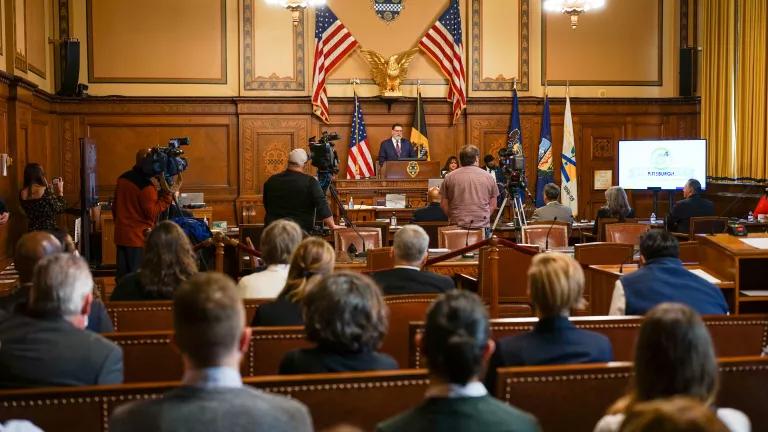
As the extreme drought in California has persisted (now deep into its fifth year), water agencies and homeowners have increasingly recognized the benefits of replacing water-intensive grass lawns with native or water-efficient plants, which use significantly less water. In Southern California, nearly half of our treated drinking water is used outdoors to water grass and other thirsty plants. In a time of serious drought and with climate change increasingly threatening water supplies, there is growing recognition that thirsty grass is no longer appropriate for ornamental landscapes in California.
While the potential water savings from converting turf grass to more water-efficient landscapes have been extensively analyzed (including by NRDC and the Pacific Institute for our Untapped Potential report), little research has been conducted into other possible impacts until now. Researchers at the University of Southern California (USC) recently published a study examining the potential impact of widespread adoption of drought-tolerant landscaping on temperatures in Los Angeles.
The modelling is an interesting glimpse of how improving our landscaping choices to reduce water use can also lessen the impact of warming air temperatures in the Los Angeles area, due to climate change as well as the heat island effect of paved and built-over landscapes. Here’s what the study analyzed and found.
Scenarios Reveal Different Temperature Impacts
The study models the potential temperature effects in Southern California under two different landscape conversion scenarios:
- Conversion of all existing lawns to drought tolerant landscaping; and
- Conversion of all existing vegetative cover (i.e., urban trees and lawns) to drought tolerant landscaping.
Both scenarios suggest possible decreases of almost 6°F in nighttime temperatures due to reduced soil moisture resulting from the lack of irrigation. Drier soil is less able to transfer heat between the land surface and the underlying subsurface. Consequently, the surface and air are cooler because less heat is released from the soil. During the day, the reverse is true. The surface and air are warmer than if the soil was wetter because less heat is absorbed by the soil.
However, the two scenarios diverge on projected effects on daytime temperatures. Under the first scenario (conversion of all turf grass), there is a projected increase in average air temperatures of slightly more than 1°F across the region due to reduced evapotranspiration rates and the soil-surface interactions discussed previously. While these effects are intensified under the second scenario (conversion of all urban trees and lawns), there is a stronger daytime sea breeze facilitated by the more pronounced temperature differences between the land and sea as well as reduced surface friction (due to conversion of trees to shorter vegetation). This stronger sea breeze leads to cooler air supplanting warmer air in the region, which more than offsets the effect of increased land surface warming, resulting in average air temperature reductions of 0.4°F.
While there is a projected increase in daytime temperatures under the first scenario, the cooler nighttime temperatures more than compensate for it. In fact, the study notes that at night, the urban heat island effect is the most prevalent and the impact of higher nighttime temperatures “poses further risk to public health as it limits people’s ability to cool down and recover before exposure to the next day’s high temperatures.” So in an era of climate change, cooler nighttime temperatures provide an important public health benefit.
Understanding the Study’s Limitations
As intriguing as these modelling results are, the study’s limitations need to be considered. First and foremost, the two scenarios used are not representative of real world conditions. From a policy perspective, achieving 100 percent conversion of all turf grass to drought-tolerant landscaping would be extremely difficult if not downright impossible, nor would it be even desirable where grass is distinctly useful, such as on playing surfaces. Given that challenge, the second scenario is even more hypothetical, and the study puts it mildly when it calls this scenario “extreme.” It is difficult to envision anyone advocating for eliminating trees given their many benefits, such as reducing temperatures, improving water quality and supply, cleaning the air, and providing critical habitat for people and wildlife. And notably, the model used in the study doesn’t account for the potential effect of removing shade provided by the tree canopy so the actual site-specific temperature effects observed are likely to differ from the model’s projections.
Second, as tempting as it might be, the study’s results are not easily applicable to other areas of California or other regions in the U.S. The Los Angeles metro region has unique topographical and climatological features, which result in a variety of microclimates that are characterized by dramatic temperature differences. Temperatures can vary by as much as 20°F or more between neighborhoods that are separated by as little as 10 miles in distance. And these temperature contrasts will likely become even starker due to climate change. The region’s microclimates also can be seen in the study’s results, where the precise potential warming and cooling effects vary based on location.
Making Conservation A Way of Life
While the USC study highlights the complex dynamics that affect temperature at the local and regional levels, it also provides evidence of the multiple benefits that we can achieve by pursuing water-saving landscapes. Lowering temperatures in cities in hot climates is likely to become increasingly urgent in a climate-changed future. For example, during the 2006 California heat wave, researchers estimate that 350-450 people died due to heat-related illnesses and 16,000 more emergency room visits occurred as temperature records were broken.
As Governor Brown stated in his recent executive order, we need to "make conservation a California way of life" so that our precious water resources are used more sustainably. The extreme drought has exposed our current approach to using water in California as unsustainable. Even in normal years, we lack the water necessary to maintain the flows needed to protect the health of the Bay-Delta estuary and other rivers across the state while meeting the demands of farms and cities.
With drought conditions still affecting more than 80 percent of the state and the growing likelihood that we’ll see a hotter and drier future, we need to take prudent steps to use our limited supplies more responsibly and sustainably. And reducing the amount of drinking water that is used outdoors for irrigation is a critically important part of helping achieve that goal.


